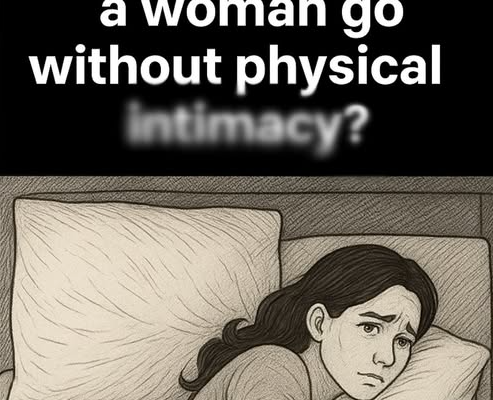
How Long Can a Woman Live Without Physical Intimacy? Understanding the Body, Mind, and Heart Behind the Question
It’s a question that has fascinated scientists, psychologists, and everyday people alike: How long can a woman live without physical intimacy? On the surface, it sounds biological — a matter of hormones and health. But underneath lies something much deeper: the human need for connection, affection, and closeness.
Let’s look at this from every angle — physical, emotional, and spiritual — to uncover what really happens when physical intimacy takes a backseat in a woman’s life.
1. The Body’s Design for Connection
Human beings are wired for touch. From the moment we’re born, physical contact — a hug, a hand-hold, or a gentle brush on the arm — releases a hormone called oxytocin, often nicknamed the “bonding hormone.” It reduces stress, lowers blood pressure, and strengthens feelings of trust.
But does that mean a woman needs physical intimacy to survive?
Not necessarily. There’s no biological timer that counts down when intimacy stops. The human body can continue functioning perfectly without sexual or romantic touch. However, the effects on emotional well-being can be significant over time, depending on the individual and her lifestyle.
Think of intimacy as vitamins for the soul — not absolutely required for life, but deeply beneficial for overall health.
2. The Psychological Dimension: Craving Closeness
While the physical body doesn’t depend on intimacy, the brain does crave connection. Numerous studies show that people who experience regular affectionate touch — whether through hugs, cuddling, or loving relationships — tend to have lower levels of anxiety and depression.
In contrast, prolonged isolation or lack of physical closeness can increase cortisol (the stress hormone) and feelings of loneliness. For some women, that absence can lead to mood swings, sleep issues, and even decreased self-esteem.
Yet, this is not universal. Some women channel that same need for connection into other fulfilling experiences — friendships, creative expression, volunteering, spirituality, or caring for family and pets. Emotional satisfaction, not necessarily physical intimacy, becomes their source of balance.
3. Redefining Intimacy
It’s important to separate “physical intimacy” from “sexual activity.” Intimacy simply means closeness — the sense of being understood, accepted, and safe with another person.
For many women, this can exist without any sexual component. Deep friendship, heartfelt conversation, a warm embrace from a loved one, or even time spent in self-reflection can all fill the same emotional need for connection.
In fact, researchers have found that people who cultivate non-romantic forms of intimacy — such as empathy, shared goals, and emotional openness — experience higher long-term satisfaction than those who rely solely on physical connection.
So, a woman can live for years, even decades, without sexual intimacy — and thrive — if she has other forms of meaningful connection in her life.
4. Physical Health Effects of Abstinence
From a strictly biological standpoint, abstaining from sex or physical intimacy does not harm a woman’s body. Hormone levels fluctuate naturally with age, stress, and lifestyle, but no essential system shuts down due to lack of intimacy.
However, certain benefits of intimacy — such as improved cardiovascular health, endorphin release, and better sleep — may be less frequent without it. On the other hand, women who lead active, balanced lives can achieve the same benefits through exercise, meditation, laughter, and positive relationships.
In other words: physical intimacy can support health, but it’s not the only path to it.
5. Emotional Consequences Over Time
For some women, long-term absence of intimacy can feel like emotional malnourishment. Humans are social creatures, and touch is one of the simplest ways we express love and belonging. Without it, even confident individuals can start to feel detached or invisible.
The longer this continues, the more a woman might question her desirability or purpose in relationships. That’s why emotional self-care — nurturing the heart through friendship, creativity, or spirituality — becomes vital.
Many women find empowerment in this stage. They redirect their energy into personal growth, discovering strength and self-love that comes from within rather than external validation.
6. The Role of Age and Life Stage
Age can influence how a woman experiences the absence of intimacy.
-
Younger women may feel a stronger social or biological urge for closeness, partly due to hormonal activity and cultural expectations around relationships.
-
Middle-aged women often experience shifts in priorities — focusing more on career, family, or self-discovery. The need for physical intimacy might lessen or evolve into emotional intimacy.
-
Older women may find comfort in companionship and emotional connection rather than physical interaction. Many report a newfound peace in independence and self-acceptance.
At every stage, what matters most is not the presence or absence of intimacy, but how she relates to herself and whether her emotional needs are being met.
7. Spiritual and Psychological Renewal
Many faiths and philosophies see periods of abstinence as opportunities for clarity, strength, and spiritual growth. Throughout history, countless women — nuns, monks, healers, and writers — have lived full, meaningful lives without romantic or physical intimacy.
These women often describe a sense of freedom — a redirection of passion toward creativity, prayer, service, or purpose. It suggests that while the body might crave touch, the soul can find fulfillment in deeper, non-physical connections.
8. Modern Pressures and Misconceptions
Society often equates sexual activity with vitality or worth, which can make women who are single or abstinent feel “less than.” But this mindset ignores the diversity of human experience.
There are countless ways to live a rich, joyful, intimate life without being sexually active. Intimacy with oneself — through self-care, confidence, and personal growth — can be just as healing.
True fulfillment isn’t measured by frequency of contact, but by depth of connection — with others and with one’s own heart.
9. How to Nurture Connection Without Physical Intimacy
If a woman finds herself in a season without physical closeness, here are powerful ways to maintain emotional and physical well-being:
-
Cultivate close friendships — shared laughter and understanding release oxytocin too.
-
Practice self-compassion — treat yourself with kindness and gentleness.
-
Engage in creativity — painting, writing, or music stimulate the same brain centers that intimacy does.
-
Exercise and meditate — movement and mindfulness release endorphins that promote peace and happiness.
-
Volunteer or serve — helping others creates a sense of purpose and belonging.
These aren’t substitutes; they are alternative forms of connection that feed the same emotional circuits in the brain.
10. The Final Answer
So — how long can a woman live without physical intimacy?
Physically, a lifetime. There’s no biological limit. Emotionally, however, the need for connection never disappears — it simply changes form.
Whether through love, friendship, family, faith, or creativity, the essence of intimacy can live on. The real key isn’t physical touch, but emotional fulfillment — the sense of being seen, valued, and connected to something larger than oneself.
A woman can go years without physical intimacy and still thrive — as long as she continues to nurture the deeper forms of closeness that make life rich and meaningful.


